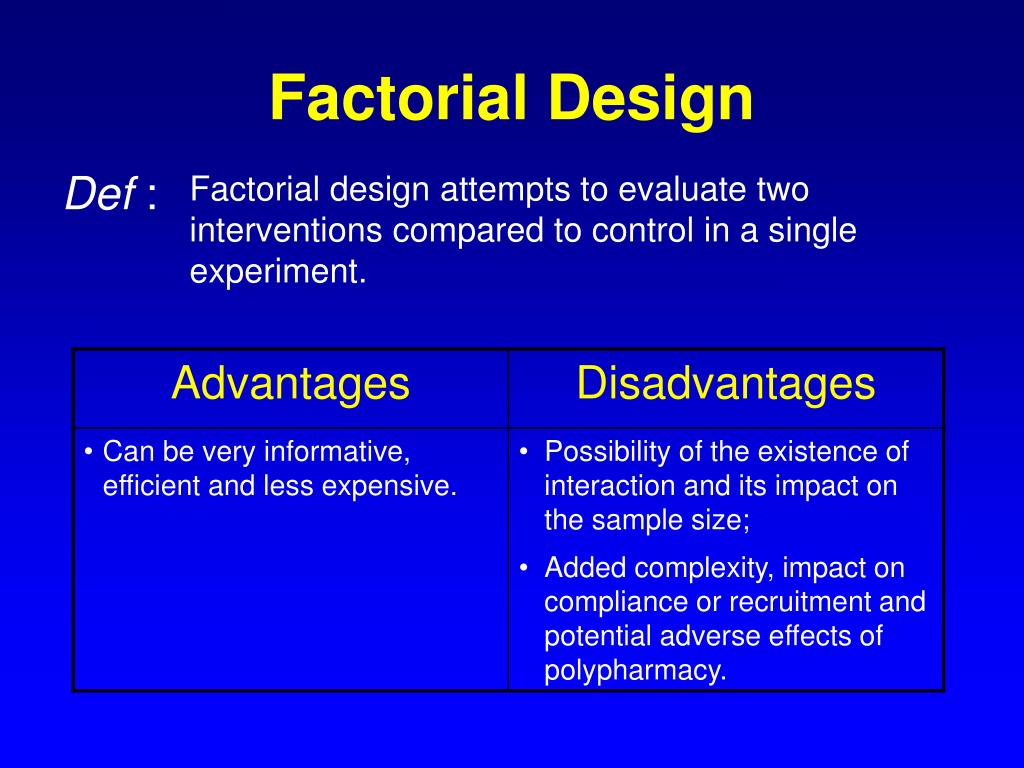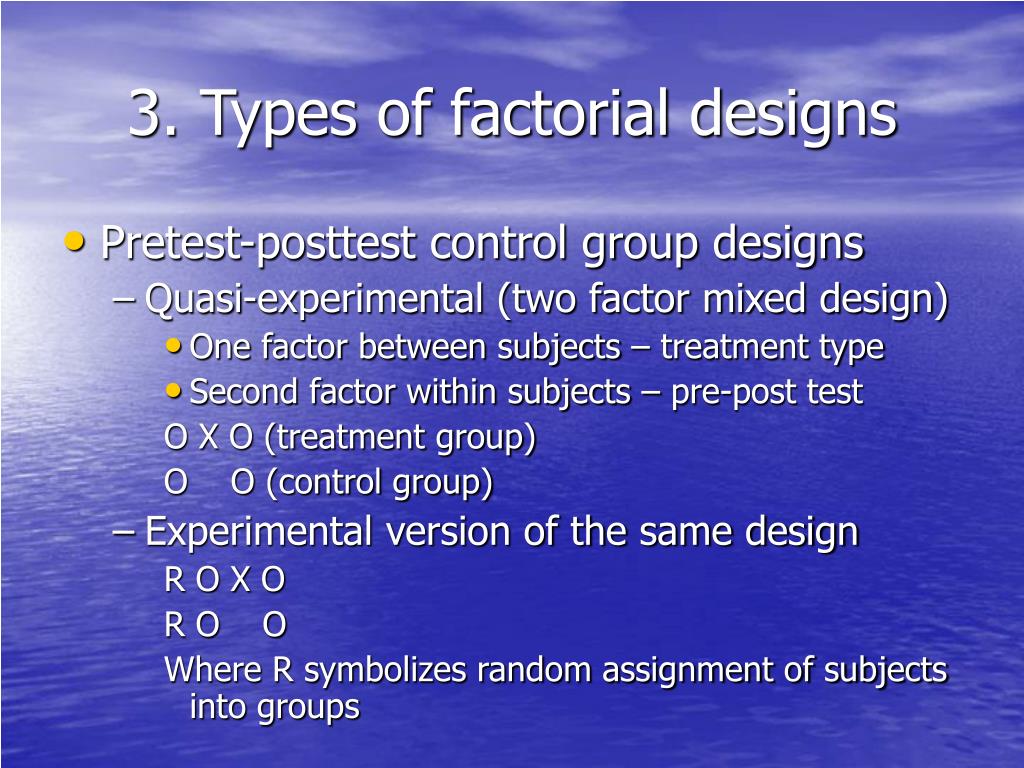Table Of Content

If the interaction term is significant that tells us that the effect of A is different at each level of B. Or you can say it the other way, the effect of B differs at each level of A. Therefore, when we have significant interaction, it is not very sensible to even be talking about the main effect of A and B, because these change depending on the level of the other factor.
3.4. What makes a people hangry?¶
The research then also measure participants’ willingness to have unprotected sexual intercourse. This study can be conceptualized as a 2 x 2 factorial design with mood (positive vs. negative) and self-esteem (high vs. low) as between-subjects factors. This design can be represented in a factorial design table and the results in a bar graph of the sort we have already seen.
Solvent bar microextraction combined with HPLC-DAD and multivariate optimization for simultaneous determination of ... - ScienceDirect.com
Solvent bar microextraction combined with HPLC-DAD and multivariate optimization for simultaneous determination of ....
Posted: Tue, 30 Aug 2022 06:16:40 GMT [source]
2: Design of experiments via factorial designs
The between-subjects design is conceptually simpler, avoids carryover effects, and minimizes the time and effort of each participant. The within-subjects design is more efficient for the researcher and help to control extraneous variables. In a between-subjects factorial design, all of the independent variables are manipulated between subjects. For example, all participants could be tested either while using a cell phone or while not using a cell phone and either during the day or during the night. This would mean that each participant would be tested in one and only one condition.
1. Multiple Dependent Variables¶
But they might choose to treat time of day as a between-subjects factor by testing each participant either during the day or during the night (perhaps because this only requires them to come in for testing once). Thus each participant in this mixed design would be tested in two of the four conditions. In the remainder of this section, we will focus on between-subjects factorial designs only. Also, regardless of the design, the actual assignment of participants to conditions is typically done randomly. Recall that in a between-subjects single factor design, each participant is tested in only one condition. In general, when dummy coding is used, the effects corresponding to main effects in a standard ANOVA are similar to simple effects, i.e., the effect of a variable when all other variables in the model are set to the level coded as zero.
Investigators may wish to adjust ICs to enhance their compatibility with other components. For instance, investigators might choose to reduce the burden of an IC by cutting sessions or contact times. This might reduce the meaning of the factor because it might make the IC unnecessarily ineffective or unrepresentative. Other than these slight detractions, a factorial design is a mainstay of many scientific disciplines, delivering great results in the field. Traditional research methods generally study the effect of one variable at a time, because it is statistically easier to manipulate.
For example, the levels of an 6-level factor might simply be denoted 1, 2, ..., 6. If the number of combinations in a full factorial design is too high to be logistically feasible, a fractional factorial design may be done, in which some of the possible combinations (usually at least half) are omitted. The normal probability plot of the effects shows us that two of the factors A and C are both significant and none of the two-way interactions are significant. Next, what we really want to look at is the factorial plots for these three factors, B, C and D and the interactions among these, BD and BC. All of the black dots are in fairly straight order except for perhaps the top two. If we look at these closer we can see that these are the BD and the BC terms, in addition to B, C, and D as our most important terms.
This might result in subadditive or negative interactions in which interventions produce less benefit, or even produce net decreases in benefit, when they co-occur with another intervention(s). This can pose interpretive challenges as it may be difficult to separate the effects of a component per se from the impact of burden. A factorial design is often used by scientists wishing to understand the effect of two or more independent variables upon a single dependent variable. Our analysis of variance has three main effects, three two-way interactions, a three-way interaction and error. If this were conducted as a Completely Randomized Design experiment, each of the a × b × c treatment combinations would be randomly assigned to n of the experimental units.

Graphical Approaches to Finding a Model
In the two factor case, this is just an extension of what we did in the one-factor case. But now we have the marginal means benefiting from a number of observations per cell and the number of levels of the other factor. In this case, we have n observations per cell, and we have b cells. The estimates of the interaction and main effects are given in the text in section 5.3.4.
Thus, a significant main effect reflects an experimental effect that occurs on average across all other factors in the model even when the relevant factor is involved in significant interactions (Chakraborty et al., 2009). Including additional factors in an experiment might certainly affect the significance tests of a given factor. The reduction in power will be greater if we control experiment-wise error, due to the larger number of main and interaction effects. Including numerous factors might also increase the occurrence of interactions, which might affect the magnitude of a main effect (despite the lack of correlation between main and interaction effects with effect coding). Finally, including numerous ICs in an experiment could cause staff or counselors to spontaneously adjust their delivery of an intervention component because of their awareness of the total intensity of treatment provided to a participant. This could certainly affect the external validity of the results.
From the example above, suppose you find that 20 year olds will suffer from seizures 10% of the time when given a 5 mg CureAll pill, while 20 year olds will suffer 25% of the time when given a 10 mg CureAll pill. When 40 year olds, however, are given a 5 mg pill or a 10 mg pill, 15% suffer from seizures at both of these dosages. There is an increasing chance of suffering from a seizure at higher doses for 20 year olds, but no difference in suffering from seizures for 40 year olds. Thus, there must be an interaction effect between the dosage of CureAll, and the age of the patient taking the drug. When you have an interaction effect it is impossible to describe your results accurately without mentioning both factors.
Various approaches have been suggested for dealing with the challenge posed by so many statistical comparisons being afforded by complex factorial designs (Couper et al., 2005; Green, Liu, & O’Sullivan, 2002). As opposed to an RCT, where the focus is on demonstrating effects that are highly unlikely to be due to chance, the screening experiment is focused on relative promise of the tested ICs. When taking a general linear model approach to the analysis of data from RCTs and factorial experiments, analysts must decide how to code categorical independent variables. This problem is avoided if an analysis of variance package is used, because such packages typically default to effect coding.
From this one can see that there is an interaction effect since the lines cross. One cannot discuss the results without speaking about both the type of fertilizer and the amount of water used. Using fertilizer A and 500 mL of water resulted in the largest plant, while fertilizer A and 350 mL gave the smallest plant. Fertilizer B and 350 mL gave the second largest plant, and fertilizer B and 500 mL gave the second smallest plant. There is clearly an interaction due to the amount of water used and the fertilizer present. Perhaps each fertilizer is most effective with a certain amount of water.
Factorial designs are so useful because they allow researchers to find out what kinds of variables can cause changes in the effects they measure. We measured the distraction effect, then we found that reward causes changes in the distraction effect. If we were trying to understand how paying attention works, we would then need to explain how it is that reward levels could causally change how people pay attention (because science is cumulative). We would have some evidence that reward does cause change in paying attention, and we would have to come up with some explanations, and then run more experiments to test whether those explanations hold water.

No comments:
Post a Comment